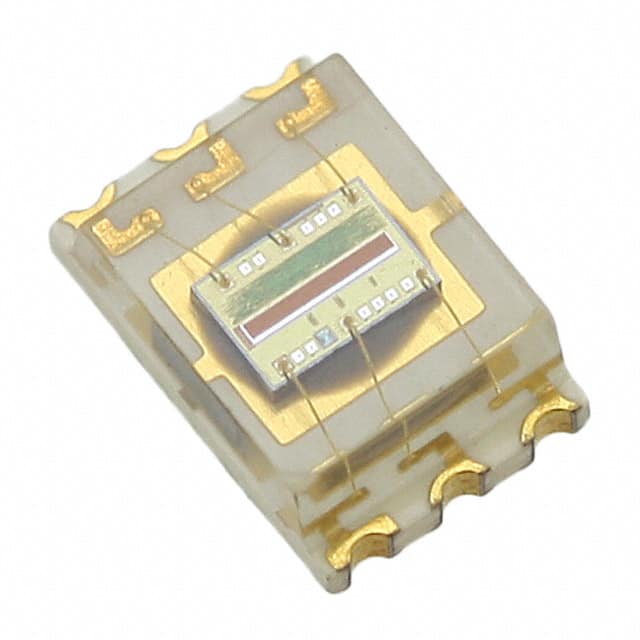Viz Specifikace pro podrobnosti o produktu.

TSL2569T
Product Overview
The TSL2569T is a light-to-digital converter belonging to the category of ambient light sensors. It is commonly used in various electronic devices to measure the ambient light intensity and provide digital output for controlling display brightness, backlighting, and other lighting-related functions. The TSL2569T is known for its high sensitivity, low noise, and wide dynamic range, making it suitable for diverse applications. It is typically available in small surface-mount packages and can be purchased individually or in bulk quantities.
Specifications
- Package Type: Surface-mount
- Sensitivity Range: 0.01 lux to 40,000 lux
- Output: Digital (I2C)
- Operating Voltage: 2.7V to 3.6V
- Low Power Consumption: 0.65 mA typical
- Integrated IR Rejection: Yes
Detailed Pin Configuration
The TSL2569T features a standard pin configuration with specific pins dedicated to power supply, I2C communication, and output control. The detailed pin configuration is as follows: 1. VDD - Power Supply 2. SDA - I2C Data 3. SCL - I2C Clock 4. INT - Interrupt Output 5. ADDR - I2C Address Selection 6. GND - Ground
Functional Features
- High Sensitivity: Capable of detecting very low light levels
- Wide Dynamic Range: Suitable for use in varying lighting conditions
- Integrated IR Rejection: Minimizes interference from infrared sources
- Low Power Consumption: Ideal for battery-powered devices
- I2C Interface: Allows for easy integration with microcontrollers and other digital systems
Advantages and Disadvantages
Advantages
- Accurate and reliable light sensing capabilities
- Low power consumption for energy-efficient operation
- Integrated IR rejection enhances accuracy in real-world lighting environments
- Compact surface-mount package for easy integration into compact designs
Disadvantages
- Limited to digital output, may require additional components for analog applications
- Sensitive to external electromagnetic interference in certain operating conditions
Working Principles
The TSL2569T operates based on the principle of converting incident light into a digital signal through an integrated photodiode array and analog-to-digital converter. The sensor's internal circuitry processes the light input and provides a digital output that corresponds to the ambient light intensity. This digital output can then be utilized by the host system to adjust lighting parameters or make informed decisions based on the surrounding light conditions.
Detailed Application Field Plans
The TSL2569T finds extensive application in various fields, including but not limited to: - Mobile Devices: Automatic display brightness adjustment - IoT Devices: Ambient light monitoring for smart home applications - Automotive: Adaptive interior lighting control - Industrial Equipment: Light-sensitive automation and control systems - Consumer Electronics: Energy-efficient backlighting solutions
Detailed and Complete Alternative Models
For users seeking alternative ambient light sensors, several models can be considered as alternatives to the TSL2569T, including: - TSL257-LF: Lower power consumption variant - TSL2591: Higher resolution and extended dynamic range - OPT3001: Analog output with similar sensitivity range
In conclusion, the TSL2569T offers a reliable and versatile solution for ambient light sensing applications, with its high sensitivity, wide dynamic range, and integrated IR rejection setting it apart in the market. Its compact form factor and low power consumption make it an attractive choice for designers looking to incorporate accurate light sensing capabilities into their products.
[Word Count: 529]
Seznam 10 běžných otázek a odpovědí souvisejících s aplikací TSL2569T v technických řešeních
What is the TSL2569T sensor used for?
- The TSL2569T sensor is used for ambient light sensing in a variety of applications, including display backlight control, keyboard illumination control, and automatic brightness adjustment in mobile devices.
What is the spectral response range of the TSL2569T sensor?
- The TSL2569T sensor has a spectral response range of approximately 300nm to 1050nm, making it suitable for a wide range of ambient light sensing applications.
How does the TSL2569T sensor communicate with microcontrollers or other devices?
- The TSL2569T sensor typically communicates using an I2C interface, allowing for easy integration with microcontrollers and other digital devices.
What is the resolution of the TSL2569T sensor?
- The TSL2569T sensor has a high-resolution output, providing 16-bit digital output for precise ambient light measurements.
Can the TSL2569T sensor be used in outdoor environments?
- Yes, the TSL2569T sensor can be used in outdoor environments, as it is designed to handle a wide range of ambient light conditions.
What are the power requirements for the TSL2569T sensor?
- The TSL2569T sensor typically operates at low power, making it suitable for battery-powered devices and energy-efficient applications.
Is the TSL2569T sensor suitable for use in automotive applications?
- Yes, the TSL2569T sensor is suitable for automotive applications, such as automatic headlight control and interior lighting adjustments based on ambient light levels.
Does the TSL2569T sensor have built-in features for flicker rejection?
- Yes, the TSL2569T sensor includes built-in features for flicker rejection, ensuring accurate ambient light measurements even in the presence of artificial lighting sources.
Can the TSL2569T sensor be used in conjunction with other sensors for environmental monitoring?
- Yes, the TSL2569T sensor can be integrated with other sensors to provide comprehensive environmental monitoring solutions, such as in smart home automation systems.
Are there any specific considerations for calibrating the TSL2569T sensor in different applications?
- Calibration of the TSL2569T sensor may be necessary based on the specific application requirements, and it is important to follow the manufacturer's guidelines for proper calibration procedures.

